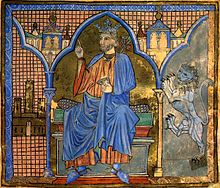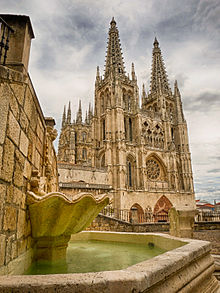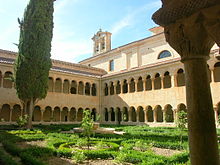Kingdom of Castile
The Kingdom of Castile (Latin: Regnum Castellae) was one of the medieval kingdoms of the Iberian Peninsula. Castile emerged as an autonomous political entity in the IX century as a county vassal of León, reaching the category of «kingdom» in the 11th century. Its name was due to the large number of castles that were in the area.
During the X century, its counts increased their autonomy, but it was not until 1065 that it separated from the kingdom of León and became a kingdom in its own right. Between 1072 and 1157 it was reunited with León, and after 1230 this union became permanent. Throughout this period, the Castilian kings made extensive conquests in southern Iberia at the expense of the Islamic principalities. The kingdoms of Castilla y León, with their southern acquisitions, became known collectively as the crown of Castile, a term that also came to encompass overseas expansion.
History
Background: County of Castilla (850-1065)
The first mention of «Castilla» appears in a document from the year 800: «We have built a church in honor of San Martín, in the Area Patriniano, in the territory of Castilla».
In the Chronicle of Alfonso III (King of Asturias, IX century) it says: «The Vardulias are now called Castile".
Eo tempore populantur Primorias, Lebana, Transmera, Supporta, Carranza, Bardulia quae nunc appellatur Castella.Chronicle of Alfonso III
The county of Castilla is repopulated mainly by inhabitants of Cantabrian, Asturian, Basque origin with their own Romance dialect, Castilian, and with different laws.
The first Count of Castile is Rodrigo in 860 (under Ordoño I of Asturias and Alfonso III the Great). The County of Castilla experienced a great expansion during the government of Count Rodrigo, who headed south until he reached Amaya (860) and at the expense of the Cordovans through La Rioja. Furthermore, after the revolt of Count Eglyón from Álava, Álava was incorporated into the County of Castilla. In the year 931, the county of Castilla was unified with Count Fernán González, making his domain a hereditary county behind the backs of the kings of León.
In 1028, Sancho III El Mayor of Pamplona acquired the county of Castilla after the death of Count García Sánchez, since he was married to his sister. As his inheritance, in 1035 he left a diminished county of Castile to his son Ferdinand.
Creation of the independent kingdom and unions with Leo (1065-1230)
- The Will of Fernando I the Magno
Ferdinand, who had inherited the county of Castile in 1035 after the division of the kingdom of Pamplona on the death of his father Sancho III, was married to Sancha de León, sister of Bermudo III. The count provoked a war in which the Leonese sovereign died in the battle of Tamarón against the Castilian-Pamplona coalition. Since Bermudo III had no offspring, his brother-in-law Fernando appropriated the Leonese crown, wielding the rights of his wife and on June 22, 1038, he was anointed King of León —Fernando I—.
At the end of 1063, probably on December 22, taking advantage of the fact that numerous magnates had gathered in the capital of the kingdom for the consecration of the Basilica of San Isidoro de León, Fernando I convened a Curia Regia to publicize his testamentary provisions, in which he decided to distribute his patrimony among his children, following the Navarrese tradition of dividing the kingdoms among their heirs, a distribution that would not become effective until the death of the monarch in order to avoid that discords arose after his death.
The Kingdom of León belonged to Alfonso, "the most extensive, valuable and emblematic part: that which contained the cities of Oviedo and León, cradles of the Asturian-Leonese monarchy", which included Asturias, León, Astorga, El Bierzo, Zamora with Tierra de Campos as well as the pariahs of the Toledo taifa. His older brother, Sancho, received the Kingdom of Castile, created by his father for him, and the outcasts over the Taifa kingdom of Zaragoza. His younger brother, García, received the entire region of Galicia, " elevated to the category of kingdom" which extended south to the Mondego river in Portugal plus the outcasts of the Taifa king of Badajoz and Seville. income from all monasteries belonging to the royal patrimony" on the condition that they could not marry.
Sancho II of Castile allied with Alfonso VI and between them they conquered Galicia. Sancho attacked his brother Alfonso and occupied León with the help of El Cid, thus producing the first union between the kingdoms of Castile and León. Thanks to Urraca, the bulk of the Leonese army took refuge in Zamora, which Sancho surrounded and where the Castilian king was assassinated in 1072 by the Leonese nobleman Vellido Dolfos, and the Castilian troops withdrew. In this way Alfonso VI took control of all the territory of his father.
- Union with Lion under the reigns of Alfonso VI, Urraca, and Alfonso VII the Emperor
Alfonso VI ruled as king of León, Castilla and Galicia, maintaining the union of the kingdoms of León and Castilla carried out by his brother Sancho. However, two kingdoms continued to exist, differentiated in administration, Romance languages, and law. After the death of Sancho IV of Navarre in 1076, territories previously belonging to the kingdom of Navarre became part of the kingdom of Castile —then united to the kingdom of León under the reign of Alfonso VI: La Rioja, Álava, Vizcaya and part of Guipuzcoa; part of these territories were recovered by Sancho VI of Navarre in the second half of the XII century; and did not return to Castilian rule until its final conquest by Alfonso VIII at the end of the XII century.
With Alfonso VI there was also a rapprochement with the rest of the European kingdoms, especially France; he married his daughters Urraca and Teresa to Raymond of Burgundy and Enrique. In the council held in Burgos in 1080, the typical Mozarabic rite was replaced by the Roman one.
On the death of Alfonso VI, his daughter Urraca succeeded him on the throne. She married Alfonso I of Aragon in her second nuptials, but failing to achieve the unification of the kingdoms and due to the great class conflicts between the two kingdoms, Alfonso I repudiated Urraca in 1114, which exacerbated the confrontations between the two. kingdoms. Although Pope Pascual II had previously annulled the marriage, they were still together until that date. Urraca also had to confront her son, King of Galicia, to enforce her rights over that kingdom, and at her death the same son succeeded her as Alfonso VII, the result of her first marriage. Alfonso VII manages to annex lands from the kingdoms of Navarra and Aragon (due to the weakness of these kingdoms caused by their secession on the death of Alfonso I of Aragon). He renounced his right to conquer the Mediterranean coast in favor of the new union of Aragon with the County of Barcelona (Petronila and Ramón Berenguer IV). Alfonso VII is entitled in 1135 Imperator Legionensis et Hispaniae in León.
- Separation of Lion after the will of Alfonso VII the emperor
Alfonso VII returned to the royal tradition of dividing his kingdoms among his sons. Sancho III becomes King of Castile and Fernando II, King of León. In the Sahagún treaty of 1158 between Sancho and Fernando, the limits with the kingdom of León were established unofficially to the south of the Central system on the Guinea road.
The minority of Alfonso VIII of Castile, who succeeded the ephemeral reign of Sancho III, caused a period of instability in Castile and part of its territories were occupied by the kingdom of León. a period of Castilian consolidation; he conquered the city of Cuenca in 1177. He also incorporated Álava, Guipúzcoa and Duranguesado into the kingdom of Castile in 1200, leaving these territories outside the orbit of the kingdom of Navarre. The defeat of Alarcos in 1195, however, constituted a severe setback to the Castilian expansion, moving the border line with the Almohads to the north and being besieged by these cities of the Tagus valley such as Toledo, Madrid and Guadalajara in 1197.
Final union with the kingdom of León: the crown of Castile (since 1230)
The history of the two kingdoms of Castile and León came together again in the year 1230, when Ferdinand III the Saint received the kingdom of Castile from his mother Berenguela (in 1217) and from his deceased father Alfonso IX (in 1230) that of Leon. Likewise, he took advantage of the decline of the Almohad Empire to conquer the Guadalquivir valley while his son Alfonso took the kingdom of Murcia. When Ferdinand III became King of León after the death of Alfonso IX of León, the Cortes of León and Castilla were merged, at which time the crown of Castile is considered to have arisen, made up of two kingdoms: Castilla y León, as well as taifas and lordships conquered from the Arabs (Córdoba, Murcia, Jaén, Seville). The kingdoms kept their law (for example, people from the Kingdom of Castile who were tried in the Kingdom of León applied the law of that Kingdom and vice versa).[citation required]
The House of Trastámara was a dynasty that reigned in Castile between 1369 and 1555, in Aragon from 1412 to 1555, in Navarre between 1425-1479 and 1513-1555, as well as in Naples between 1458-1501 and 1504-1555. He took the name of the count (or duke) of Trastámara, a title used by Enrique II of Castile, el de las Mercedes, before he came to the throne in 1369; that is, during the civil war with his legitimate brother Pedro I. Enrique would have been raised and educated by Count Rodrigo Álvarez. On the death of Juan II, his daughter Leonor inherited Navarre and her half-brother, Fernando called the Catholic, the crown of Aragon. Ferdinand's marriage to Isabel I of Castilla, celebrated on October 19, 1469, in the Palacio de los Vivero, in Valladolid, established the union between these two crowns, which became effective and definitive when their daughter Juana I, Queen of Castilla since 1504, also received the Aragonese crown in 1516, also proclaiming his son Carlos I as king of both crowns.
The increase in the circulation of precious metals from the price revolution that began in the middle of the XVI century involved a process inflation that harmed exports from Castilla, due to a loss of price competitiveness. That ruined part of the wool manufacturing industry and other industries.
Government: monarchs, councils and courts
Like all medieval kingdoms, supreme power “by the grace of God” rested with the king. But rural and urban communities are beginning to emerge, making decisions about their daily problems.
These bodies will evolve into councils (or local assemblies), in which some residents will represent the whole. They will also achieve greater power, such as the election of magistrates and officials, mayors, town criers, notaries, and other proper officials.
Given the growing power of these councils, and the need for their communication with the king, the Cortes arose, first in the Kingdom of León, in 1188; and then its corresponding version in the Kingdom of Castile, in 1250. In the medieval Courts, the inhabitants of the cities were a small group, known as laboratores. The Cortes did not have legislative powers, but they were a point of union between the king and the kingdom, something in which León and Castilla were pioneer kingdoms.
Symbols of the Kingdom of Castile
Around 1175, during the reign of Alfonso VIII, the speaking arms of Castile —that is, a castle— began to be used as a heraldic symbol on seals.
Society
- The development of cities. The burgos
On the route of the Camino de Santiago, villages arose from La Rioja to the Kingdom of Galicia from the XI century. The Camino de Santiago is of vital importance for the development of Burgos. About this city, the Arab geographer Al-Idrisi writes in the XII century century:
It is a great city, crossed by a river and divided into neighborhoods surrounded by walls. One of these neighborhoods is particularly inhabited by Jews. The city is strong and conditioned for defense. There are bazaars, commerce and a lot of population and wealth. It is located on the great route of travelers.
To the south of the Duero river, in the then known lands of Extremadura, the birth of cities was for defensive purposes, but over time an economic and commercial activity of similar importance to the northern cities began to develop of the Douro.
The bourgeois appear, who are the inhabitants of the boroughs (not to be confused with the current meaning of the term bourgeois), who are added to clergy and nobles. The bourgeois were mainly engaged in trade and the production of manufactured objects and their growth was limited economically and socially by the nobility (mainly dedicated to the land). The arrival, due to Almohad intransigence in al-Andalus, of Jewish communities during the XI and centuries also deserves attention. ="font-variant:small-caps;text-transform:lowercase">XII, who settled mainly as artisans, merchants and farmers.
In the 12th century, Europe will witness a great advance in the intellectual field thanks to Castile. Through Islam, classical works previously forgotten in Europe will be recovered and contact will be made with the wisdom of Muslim scientists.
In the first half of the XII century, the School of Translators was created in Toledo whose main task was to translate works into Latin of various philosophical and scientific origins of classical Greece or Islam. Many European thinkers went to this center of knowledge, like Daniel de Morley, who, disappointed in the Parisian schools, traveled to Toledo to "listen to the lessons of the world's wisest philosophers."
The Camino de Santiago will only enhance the exchange of knowledge between the kingdoms of Castilla y León and Europe, in both directions.
In the XII century century, multiple religious-military orders similar to European ones also appeared, such as those of Calatrava, Alcántara and Santiago and a multitude of Cistercian abbeys were founded.
- Religious and linguistic minorities
From the X century to the XIII in the peninsular Christian kingdoms inhabited a significant number of Mudejars, Muslims who remained in territory conquered by the Christians and who were initially allowed to maintain their religion, their language and their traditions. These Muslims were grouped into aljamas or morerías with varying degrees of autonomy. In the court of Alfonso X of Castile there was a significant number of Arabic translators, some of whom were precisely Mudejars from Castile. Thus, in the first stage of Castile and until the Mudejar revolts that became especially intense until 1246, there was therefore a significant number of Andalusian Arabic speakers in Castile who also professed Islam. From the end of the XIII century with the increase in conflict between Mudejars and Christians, many of them were expelled from Castile, many of them emigrating to Aragon where Jaime I of Aragon had a more tolerant policy towards them, allowing them to keep mosques and agrarian institutions.
It is also well documented that a significant number of Jews existed in the kingdom of Castile. Although these were a religious minority, they were not a linguistic minority since Hebrew was not used as a vernacular among them. Until their final expulsion in 1492, when an estimated one hundred thousand Jews were expelled, they must have constituted a notorious religious minority.
Regarding the use of other languages, toponymy and sporadic information and notarial documents allow us to glimpse that Basque, which is not only very fragmentarily represented in written documentation, continued to be used colloquially in the north of the peninsula, It was obviously a language that differed from the Basque clearly documented from the XVI century (the invention of the printing press). helped to publish a certain number of books in that language). But because the Castilian court was practically foreign to Basque, there are no documents entirely written in Basque during the Middle Ages and therefore there is only fragmentary evidence in anecdotal mentions, place names and anthroponyms.
As for the Mozarabic, it is known that around 1085, when Toledo became part of the Castilian crown, the city was inhabited by 15-25% Mozarabic, so Mozarabic communities must have existed temporarily after the conquest, although It is presumable that in a few generations they abandoned their Romance language in favor of Spanish (unlike what happened with the Mudejar communities that did retain their language). Likewise, during certain periods of intolerance, many Mozarabs migrated to the Christian kingdoms of the north, although it does not seem that there are many testimonies of the Mozarabic language linked to these migrants.
Contenido relacionado
Scholasticism
Gothic alphabet
Shingon buddhism















